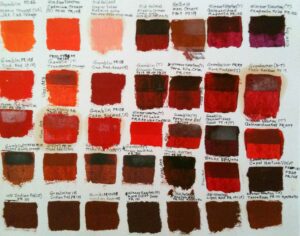What They Can Teach You About Your Oil Paints
If you have been painting for a while you may have a large collection of paints in many assorted colors or even multiple tubes of the same color from different manufacturers! Draw down cards can help you compare your paints and tell you a great deal about your colors. They are essentially paint swatches from each tube of paint you own. They can even be useful to help you quickly find the right color for an unusual painting subject.
-
Draw downs can tell you:
- How transparent or opaque the paint is.
- How fast it dries.
- If the color’s value or hue looks different when it is applied thickly or thinly.
- How oily the pigment is. Very oily paint will leave an oil ring on the card and can give you clues to how much pigment vs. oil per tube the manufacturer uses.
- If it darkens or yellows with age. You can compare the dry sample to fresh tube color.
- If the paint blooms, i.e. gets a waxy haze over the color sample, a sign the paint may have wax added to it.
- How the same color from different manufacturers varies in tone and value.

To make your own cards, first sort your tubes by color and keep the tubes with the same pigment together. For example, all cadmium red samples should be applied next to each other for ease of comparison on the cards.
In addition to your paint tubes you will need the following supplies: 14 x 17 inch pad of smooth Bristol board sheets, a thin black Sharpie marker, palette or palette paper, paper towels and a 1.5 inch hardware store putty knife.
Use one sheet of Bristol board for each color family: whites, reds and oranges, yellows, blues and purples, greens, browns and blacks.

To start, squeeze a small amount of paint onto your clean palette. Using the putty knife, scrape up the color evenly along the entire flat end of the knife and apply to the Bristol board in a square shape. For the top half apply the paint thickly and for the bottom half press hard as you draw down the putty knife. This shows you how opaque and transparent each paint sample is. Then using paper towels, carefully clean the putty knife, including the edges and you are ready for your next draw down square.
Recording the tube information isn’t as much fun as applying colored swatches but is very important. With a thin Sharpie pen note the brand, color name, pigment color numbers and type of oil, if mentioned on the label. For the whites card also record the year you make the paint swatches so you can see how fast and how much they yellow or darken. The tops of bookshelves are a good place to stash draw down cards while they dry.

Four to seven days after adding new colors check the cards to see if they are dry. Any swatch that is still wet mark “slow dry.” If some paint squares are still wet at ten to fifteen days mark them “very slow dry.” Knowing which colors dry fast or slow can be a big help when working on deadlines! When you try a new color or brand you can continue adding to the cards.
While making draw down cards can take a bit of time in the beginning, the color swatches and the information you record are invaluable. You will find yourself referring to them over and over as you work on your future paintings.

Joe Gyurcsak says
Hi Julie, this is wonderful blog and the information is that an artist can gather is very important. There are a few things to consider as advice… 1) use 100% cotton canvas primed with gesso in pads because this best shows how a painting will look and dry. Bristol board will absorb the oil into the paper fiber mak the colors look duller than they are and eventually the oil will ruin the sample boards with oil rings which will detorate the paper fiber. 2) a Blum is alumnia stearate that shows up when companies use it as a filler in an excessive manner to cut back on pigment loading.
Elizabeth R. Whelan says
This is a great idea! And thanks to commenter Joe for his info as well.
Marsha Savage says
Appreciate the post about this. I have my color charts, but this is something I have not done. I will look forward to creating mine. It will be interesting to see the difference in brands also. Thank you!